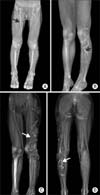Abstract
Purpose
Varicose veins requiring operative treatment have been more common recently, but there are not enough studies among children dermographics because most patients belong to the adult population. We concentrated on varicose vein of under 18 years old, and here intend to report cases of our clinical experiences.
Methods
From January 2003 until December 2014, there were 6 children under 18 years old who required varicose vein management. Data was collected by the investigation of medical records retrospectively, including preoperative symptoms, diagnostic tools, treatment methods, results of treatment, and complications.
Results
The mean age was 11 years (range, 3-17 years), and gender ratio was 1:2 (2 male, 4 female). The involved legs were on the right in 3 cases, on the left in 2 cases, and on both in 1 case. The most common symptoms were venous bulging and tortuosity in 6 cases, and other symptoms were Klippel-Trenaunay-Weber syndrome in 2 cases, pain and fatigue in 1 case, port-wine stain in 1 case, and telangiectasia in 1 case. Duplex sonography was performed to confirm venous reflux in all cases. The additional venography was performed to check for anatomical variation in 1 case, and three-dimensional CT in 2 cases. Treatments were high ligation and stripping in 3 cases, and endovenous laser therapy in 3 cases. Additionally, remnant varicosities after first operations were treated by endovenous laser therapy in all cases. During the mean postoperative follow-up period of 60 months, complications included edema of the foot and petechia in 2 cases each, and were not severe.
Figures and Tables
 | Fig. 1(A) A 3-year-old child has dilatation of the right great saphenous vein (arrow). (B) A 15-year-old child has enlargement of great and small saphenous vein (arrow). (C, D) A 7-year-old child has venous malformation of left lower leg (arrow). She has prominent venous dilatation of the thigh and knee portion (arrow). |
References
1. Ra H, Kang J, Yun HM, Lee T, Ha J, Chung JK, et al. The pattern & change of venous reflux in primary varicose vein. J Korean Soc Vasc Surg. 2005; 21:140–146.
2. Choi SS. Clinical analysis of varicose veins in the lower extremities: an analysis of 227 operative cases. Korean J Thorac Cardiovasc Surg. 1999; 32:1036–1041.
3. Hur SJ, Park HC, Lee SH, Lee KH, Koh SH, Yoon C. A clinical analysis of 604 cases of varicose veins. J Korean Soc Vasc Surg. 1999; 15:94–100.
4. Lee YJ, Park C, Kim JS, Kim HY, Yoo BH. Clinical analysis of primary varicose vein: review of 209 cases. Korean J Thorac Cardiovasc Surg. 2001; 34:909–916.
5. Chang CY, Ryu DH, Jang LC. Vein ligation combined with endovenous laser treatment in Klippel-Trenaunay syndrome: a case report. J Korean Soc Vasc Surg. 2005; 21:151–155.
6. Jacob AG, Driscoll DJ, Shaughnessy WJ, Stanson AW, Clay RP, Gloviczki P. Klippel-Trénaunay syndrome: spectrum and management. Mayo Clin Proc. 1998; 73:28–36.

7. Oduber CE, Young-Afat DA, van der Wal AC, van Steensel MA, Hennekam RC, van der Horst CM. The persistent embryonic vein in Klippel-Trenaunay syndrome. Vasc Med. 2013; 18:185–191.

8. Sermsathanasawadi N, Hongku K, Wongwanit C, Ruangsetakit C, Chinsakchai K, Mutirangura P. Endovenous radiofrequency thermal ablation and ultrasound-guided foam sclerotherapy in treatment of Klippel-Trenaunay syndrome. Ann Vasc Dis. 2014; 7:52–55.

9. Servelle M. Klippel and Trénaunay's syndrome. 768 operated cases. Ann Surg. 1985; 201:365–373.
10. Eklöf B, Rutherford RB, Bergan JJ, Carpentier PH, Gloviczki P, Kistner RL, et al. Revision of the CEAP classification for chronic venous disorders: consensus statement. J Vasc Surg. 2004; 40:1248–1252.

11. Porter JM, Moneta GL. Reporting standards in venous disease: an update. International Consensus Committee on Chronic Venous Disease. J Vasc Surg. 1995; 21:635–645.
12. Yang SJ, Park YS, Kim CS. Comparison of the operative methods for varicose veins in the lower extremities. J Korean Soc Vasc Surg. 2007; 23:168–173.




 PDF
PDF ePub
ePub Citation
Citation Print
Print




 XML Download
XML Download